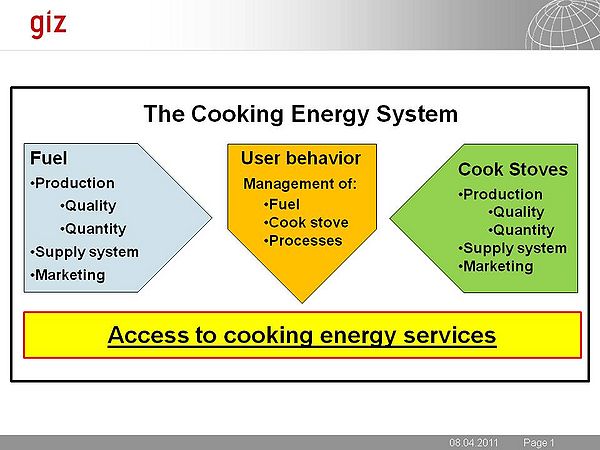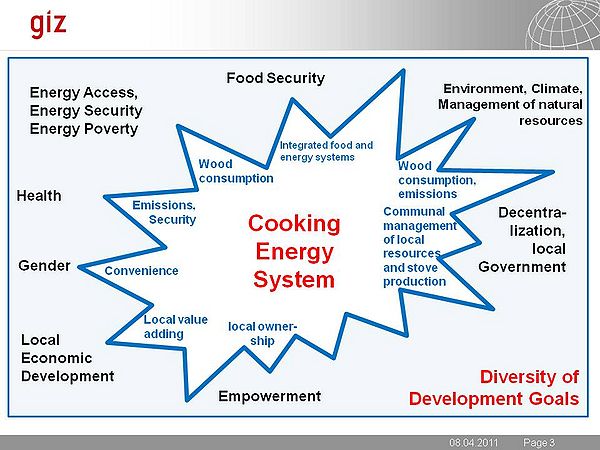Knowledge fuels change
For over a decade, Energypedia has shared free, reliable energy expertise with the world.
We’re now facing a serious funding gap.
Help keep this platform alive — your donation, big or small, truly matters!
Thank you for your support
Frame Conditions for Planning Cooking Energy Interventions
--> Back to Overview Cooking Energy Compendium
The cooking energy system
Cooking Energy is a complex system which comprises issues related to the energy supply, the end user devices (e.g. cook stoves) and the user behaviour. While fuel supply and improved cook stoves have been given a lot of attention, the users’ capacity to manage the fuel, to handle the stove in the right way and to manage the cooking process in an energy efficient way is the most difficult and neglected aspect of the cooking energy system. But only through the way people are using their resources, the actual quality of the (energy) service is realised.

|
Key intervention areas for cooking energy
80% of the cooking energy in developing countries is based on the use of biomass fuels, in particular firewood and charcoal. The key interventions of cooking energy are therefore focussed on the supply and demand side of these wood fuels.
- A) Introduction and scaling up of the efficient use of improved wood fuel stoves;
This includes both firewood and charcoal as well as both the stoves and the stove management practices. - B)Increase (sustainable) wood fuel supply and efficient wood fuel management;
This includes afforestation, sustainable forest management, efficient charcoal production and the fuel management at household level.
However, improved efficiency of wood fuel consumption and increased wood fuel supply may not be sufficient to achieve a sustainable wood fuel supply-demand system. This might also be due to other demands of competing uses of the wood and land resources required for the wood fuel supply. As a result, a complementary third key intervention is required.
- C) Promotion of alternative cooking energy options (fuels, stoves and practices);
This includes other biomass fuels, non-biomass fuels and energy-efficient cooking practices.
The national political framework conditions for cooking energy
Cooking energy is not always the key priority in national ministries dealing with energy matters. However, there still might be political ambitions, agendas, visions, prejudices against and preferences for specific technical solutions which will impact on the perception of a planning process.
In the preparation of the inception workshop, it is therefore important to assess the national political frame conditions for the planning of ICS interventions.
Here are some examples of questions which have been useful for GIZ:
- What has happened nationally in the household energy sector in the past?
- How much knowledge (and which) is still available on stoves, small business development and marketing?
- How much of this knowledge is available at the level of the ministry that is responsible for energy?
- What is the guiding vision in the ministry concerning the future of cooking energy in the country?
- What is the governments/ministries perception(s) and position(s) with regard to the use of wood fuels for cooking in rural and urban environments?
- Are there strategies or policies regarding the use of specific fuels (e.g. a ban of charcoal?)
- How do they perceive alternative fuel options for cooking energy?
- How realistic and serious are these positions (relevance for practical actions)?
- Who is either involved in, or supposed to support, the household energy sector?
- Are there other ministries (e.g. forestry, environment, agriculture) who have a mandate and policy/strategy in the field of household energy? (if Yes: What are their positions to the above?)
The planning of cooking energy interventions for programs in other sectors
Access to (cooking) energy has not been considered in the definition of the Millennium Development Goals (MDGs). In the meantime it has become clear that it is nevertheless a key requisite to achieve many of the MDGs.
Accordingly, key interventions to improve cooking energy systems are not always implemented in designated energy programs. In fact, quite often they are components in larger programs which are following other development goals.
Hence the planning of cooking energy interventions is directed towards achieving maximum synergies with the main development goals of the “hosting” program.

|
If this is the case, there are conditions or preferences towards the design of the implementation concept. As a result, many of such cooking energy components address only a section of the cooking energy system (e.g. fuel supply or supply and use of improved cook stoves respectively). Even the selection of the target group, the intervention area, the technologies and the production systems will be tailored towards supporting the requirements of the “hosting sector”.
(How) Do we reach the poor?
Poverty reduction is the overarching goal of any development intervention. However, there can be huge difference between ‘directly addressing the needs of the poor’ and concepts where poverty reduction is an effect at the outer end of the result chain.
The first step is to agree who should be considered poor in the given environment. Usually there is a strata within “the poor” which can be instrumental in the process of identifying the right target group.
Generally, four concepts of how to address specifically very poor target groups can be distinguished:
- Promotion of“non-cash” solutions
- Make “special products” for the poor available
- Make “special prices” for the poor available
- Reaching the poor by improving social services
Each of these concepts has its specific rational and approaches.

|
At some stage there seems to be a trade-off between poverty orientation and sustainability. “Non-cash” self-help stoves and highly subsidized stoves may allow reaching fast many very poor people.
However, it is not uncommon that for both approaches the duration of their impact is rather short for different reasons:
- If households produce their own stove themselves, they do not have much practice and the quality and life-span of such stoves will be low. This leads to frustration and return to the baseline stove after some years.
- If stoves are given out for free or with a very high subsidy, this approach will work until the resources to finance such approach are exhausted. As people have been made believe that stoves are cheap or for free, it is difficult to facilitate a transition to a market based approach later on.
The development of special products (to be sold at commercial rates) or the support through improved social services takes a much slower development path as compared to the free hand out or self help approach. On the other hand, in many cases the results have been more sustainable.
Top of the page
--> Back to Overview Cooking Energy Compendium



















